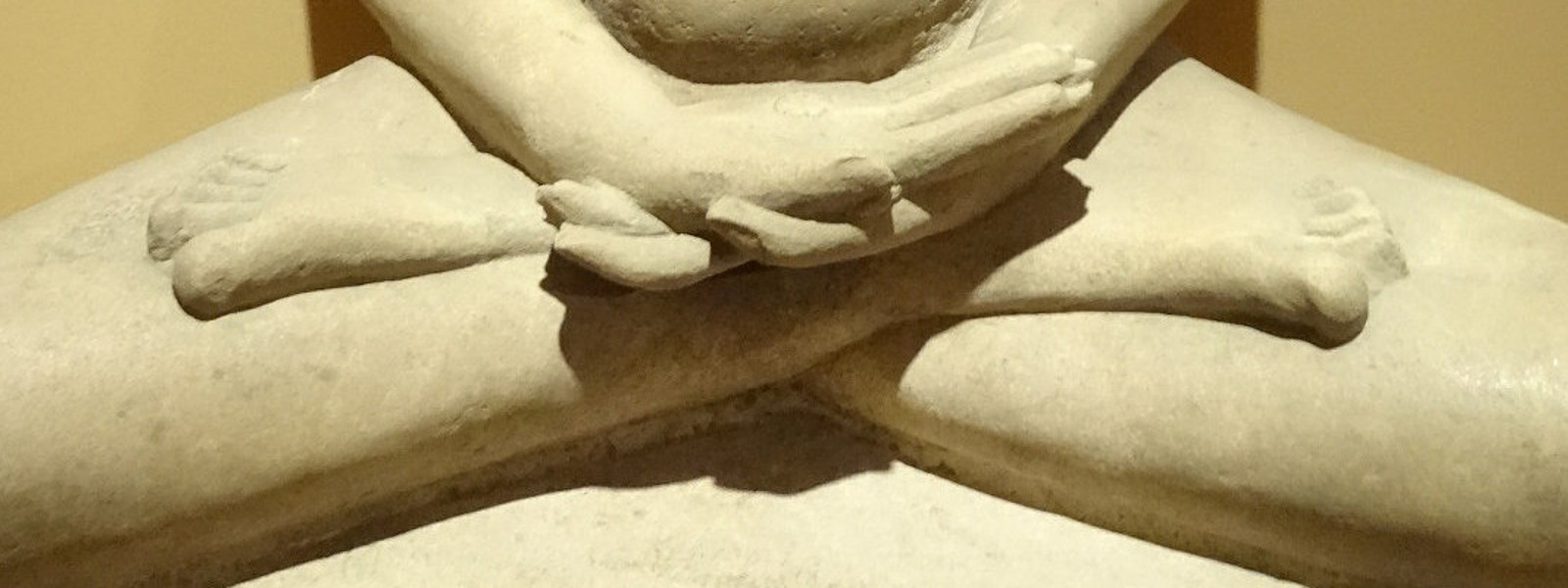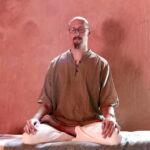This time I will talk a little bit about the meditation posture as it has often been requested. I will explore the classic postures as well as some of the less common ones such as walking, lying down or standing. I will also give you a few tips on how to train properly to achieve a good posture without injuring yourself.
The Four Postures
The Buddha has taught us to cultivate mindfulness in four postures. The four postures are known as sitting, standing, walking and lying down. It is possible to reach deeper meditative states when sitting or lying down. Walking or standing meditation are somewhat more dynamic in nature and require the mind to stay connected with the body. Another way to look at the four postures is to see them as an encouragement to practice mindfulness “all the time”.
When it comes to deeper formal meditation practice, we prefer the body to be in a resting position with just enough tension to keep us awake. That makes sitting an ideal posture for meditation. There are many ways that we can sit while mediating. Today I will explore the most common position. Please bear in mind that you don’t have to sit like that in order to dive deeply into the practice. Any posture is fine as long as it’s relaxed enough to help you forget the body and tense enough to help you stay awake.
The Benefits of a Good Sitting Posture
The main benefit of sitting well-aligned is that it will keep the body healthy and nourished throughout the session. A healthy and “open” body has a significant impact on your mental/emotional state. By cultivating good posture you therefore look after your mental and physical health. A firm position supports your meditation practice and allows you to forget the physical realm while diving deeper into inner space. As long as we can’t forget the body and our external senses, we can’t go deeper.
A good meditation pose has additional health benefits. It allows your digestion to be optimized, it regulates blood circulation and energy distribution, invigorates the nervous system and opens the lungs. Being able to breathe efficiently is dependent on the posture. Since your lungs are responsible for detoxification and nourishment you can see the importance of opening your chest and sitting straight. There are more points and I will discuss them below.
1 Legs & Hips
You can cross your legs in several different ways. There’s the regular cross-legged position, the Burmese posture, the Half-Lotus and the Full-Lotus. These are just a few, but probably the most important ones. Crossing your legs opens the hip joints and invigorates the digestive system, particularly in the full lotus position. This pose slows the flow of blood into the lower extremities and encourages the heart to work more for the upper regions of the body.
Having your legs crossed also creates a larger foundation and helps your body to “stay locked” in the posture. Again, this effect is most pronounced with the Full-Lotus pose. It helps you to prevent falling over and tilting to the sides. Think of the structure of a pyramid. It has a large base (crossed legs) and a small top (head).
2 Arms & Hands
The arms should not be pressed against the ribcage and allow for air to circulate freely around the torso. They should be loose and relaxed. The hands can be put into various positions, also known as “mudras“. All of these positions have an effect on the bio-energetic system and in turn on the mental state. However, the effects are so subtle that they we won’t recognize them if our mindfulness is still weak and unrefined. In my own opinion I would simply choose between three common hand-positions.
You can softly place your hands in your lap, right hand resting in the palm of your left, hands facing upwards. Thumbs can touch each other at the tips. If this generates too much heat or discomfort in your shoulders, you can also place your hands on your knees. Palms facing up to increase your energy and facing down to let it sink and become calming. You can experiment with these three mudras to see which one suits you best.
3 Spine & Nervous System
The spine is quite central to the meditative experience – it is very important! Straightening your spine results in increased mental clarity and alertness, better flow of energy and circulation of blood/nutrients. It also allows for your lungs to be free and open. Think of your spine as a stack of coins and align them so that the weight of your head can be felt in your pelvic floor. This takes a bit of practice, be patient with yourself.
Straightening the spine properly optimizes the way your nervous system works. This has a direct impact on the functionality of your brain. Thus this simple “tune-up” regulates a whole lot of vital tasks in your body. It will also help greatly with reducing the “thickness” of internal movies – or headflix as I call them. Take the practice with your spine really slow and do it well under the supervision of a qualified Yoga-Instructor (Yoga-teacher certificates don’t equal proper qualification and experience btw.). This is about your health – so please be careful and proceed slowly and with caution.
4 Shoulders & Chest
Opening your shoulders and your chest opens your lungs and your heart. It therefore has a significant effect on your emotional being. Opening the heart might make you feel vulnerable and insecure, fearful or anxious at first. But if you gently persist and practice under the guidance of an experienced and compassionate teacher, you can slowly release these “blockages” and transform them into a state of emotional balance.
Opening your upper back and relaxing your shoulder blades will also help alleviate some of the modern-day problems such as the forward-head-posture (FHP). It will also allow some of the trapped energy to raise upwards and nourish the head/brain with some much needed clarity and wakefulness. In the beginning this change might seem difficult to achieve but it can help a great deal with your meditative abilities.
5 Neck & Throat
Your chin and your throat should be a bit like a hook. You want to tuck your chin back towards the spine and open the back of your neck at the base of your skull. You achieve this by imagining that your head is suspended from the crown. The rest of your body feels like it “hangs” from your crown. This will also help with relaxation in the lower parts of your body.
Practice tucking your chin and opening your neck gently and regularly. You can do this in the car, in your office and everywhere else. Please don’t overdo this exercise though, particularly if you have some troubles with your spine. I recommend with all of these exercises to seek the guidance of a qualified teacher, body-worker or doctor near you. This position will greatly affect blood and energy flow up into the brain. The tucked chin will simultaneously lock the ascending heat from your torso so your mouth and eyes won’t dry out while meditating.
6 Tongue & Mouth
Place the tip of your tongue just behind the upper row of teeth. Press it gently onto the palate until you feel a slight suction, then rest your mouth. This will prevent you from having to swallow and keep the mouth comfortably hydrated at the same time. It also acts as sort of switch, connecting two of the main energetic pathways in your body.
7 Eyes & Forehead
You can either close your eyes or keep them half-open. This is a matter of preference. While closing your eyes can increase mental proliferation and drowsiness, open eyes can stimulate distraction and excitement. You would have to sit down and really observe what you like most. I like doing my formal meditation practice with closed eyes but I have noticed that sometimes it helps to have my eyes half-open.
When you meditate with half opened eyes, you will eventually loose sight and the sense of vision “blacks out” or becomes non-existent. Sometimes your eyes might take a good while to come back to normal vision after a longer session. It can also be the case that your eyes will close automatically as you get deeper. If you really meditate well, you will not feel the need to blink and your eyes will stay hydrated just fine. It might be a bit of a strange experience in the beginning.
Can I Meditate in Other Postures?
Sure! You can sit on one of these nice meditation benches or on a chair. Remember – even the Buddha sat on chairs! You could also kneel on a cushion, some people like that one. You can even lie down if you don’t fall asleep. If you are tired, take a nap first. Please don’t mix a formal meditation session with the habit of sleeping. It is another topic altogether if you are practicing lucid dreaming of course.
In short, I would say you can sit anyway you like as long as your spine and your head is upright. You shouldn’t lean either and your body should be comfortable and relaxed. This requires some specific training. I recommend Yoga! Find a teacher that shows you how to open your hips and get yourself into a classic Meditation posture. Be ready to invest some time into this process. It’s well worth it and you will learn heaps about your body and mind as you progress. Through training my posture I have gained some significant progress in my own practice. I am far from a perfect posture but I have clearly seen that it helps to learn the basics and keep refining it over time.
You could also train standing meditation – I particularly recommend the training offered at HeavenManEarth Taiji allover the world. They do a lot of standing Meditation in the course of learning the art of Taiji Chuan. They also give highly qualified guidance concerning the development of energy and internal power.
Physical Injuries
If you are a bit like me and you suffer from injuries or disabilities, don’t get disheartened. If you can’t throw a great shape you can still train your mind in just the same way. Think of the whole posture thing as traveling first class. You will reach your destination with style and comfort. You will still get there just fine if you travel economy though! You might be paralyzed, tied to a hospital bed or have no legs to cross. This should not stop you from training your mind. In my humble opinion, the physical posture is secondary and the inner posture of your heart/mind is primary.
Attitude is by far more important than perfectly crossed legs and a well trained body. If your attitude is great, you have mastered one of the most important facets of this beautiful path. Attitude is everything. You can waste years with great posture and poor attitude. So always make sure that the mind is in good shape when you sit down on your mat. This is a priority!

